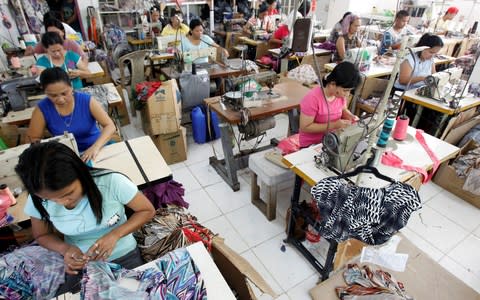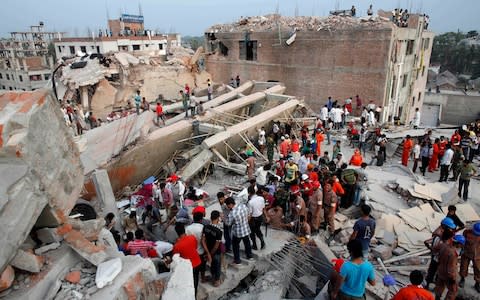Five years on from Rana Plaza, have fashion brands cleaned up their act?
It was on this day five years ago that cracks began to appear in the walls of Rana Plaza, the ill-fated complex of clothes factories and shops in Savar, 15 miles outside the Bangladeshi capital of Dhaka.
Though employees were sent home, they returned to work the following day and around 3,100 were inside when the building began to give way.
After a power outage, large generators on the roof had been fired up – sending powerful vibrations through the structure and creating more cracks in load-bearing columns.
That caused the building’s floors to collapse in on themselves, trapping thousands of workers in a concrete concertina that ultimately killed 1,138 people and left many others with life-changing injuries.
The sorry episode, one of the deadliest industrial accidents in history, shocked the world. And as clothes labels began to be plucked from the rubble, it left many major fashion brands, including Britain’s Primark, Matalan and Bonmarche, with questions to answer.
The disaster has come to be the most potent symbol of how fashion chains lost control of their supply chains as they offshored manufacturing in the pursuit of lower costs.
Even those brands who were not implicated were left with a startling reminder of how much harm they could cause by not keeping their supply chains in check.
“There is no doubt that the industry got a huge wake-up call,” says Peter McAllister, who runs the Ethical Trading Initiative, a collection of brands, trade unions and NGOs that campaign for workers’ rights.

The response in Bangladesh itself was swift with dozens of brands, including Bonmarche, Matalan and Primark, signing up to a new legally binding agreement on worker safety two months later.
History is littered with deals not worth the paper they are written on, but the Bangladesh Accord on Fire and Building Safety has by most accounts been transformative.
The tie-up included an agreement on common building standards enforced by an independent inspection programme, with factories that ignored the rules being barred from working with any of the brands involved. It also forced manufacturers to create elected health and safety committees.
A separate group set up by 17 North American retailers, the Alliance for Bangladesh Worker Safety, has taken a similar approach. Warwick Business School’s Professor Jimmy Donaghey, who has visited Bangladesh eight times since the disaster, says the accord has had an “extremely significant” impact, providing a “massive incentive” for manufacturers to raise standards.
“Employers in Bangladesh who have undergone oversight by the accord and alliance now can claim to be among the safest, if not the safest, in the world,” he adds.
There are still far too many who will hide behind contracts if it suits them
Peter McAllister, the Ethical Trading Initative
Some brands have gone even further, with Primark embarking on its own programme of building inspections and hiring an in-house structural engineer as part of its ethical trade team. But while great leaps forward have been made when it comes to building safety, it would be fanciful to suggest the global fashion supply chain is anywhere near as clean as it should be.
“Mainly we are cheap labour – that is why we are scared; we need money, we need to survive,” says Nazma Akter, who began work as a seamstress in a Bangladeshi factory aged just 11 and now runs the Sommilito Garments Sramik Federation trade union.
Those on factory floors, predominantly women, are often subjected to harassment and abuse, especially if they try to organise unions, she says, adding: “Women are still treated like they should not talk.”
One of the industry’s big headaches has been the practice of sub-contracting, where manufacturers that have been through proper inspections pass the order along to another factory down the road.
Most companies explicitly prohibit such deals in their supplier contracts, but without having a physical presence at each and every factory there is only so much they can do to ensure a particular garment has been made where it was supposed to be.
McAllister says some brands have significantly boosted the amount of time they spend in factories to keep an eye on things but they are very much in the minority.

One of the big issues has been a lack of transparency. Without knowing which firms are manufacturing where, what their policies are and how they are being enforced, it is hard for unions and campaigners to keep tabs on what they are doing and hold them to account.
Carry Somers, founder of the Fair Trade Panama hat brand Pachacuti, launched not-for-profit group Fashion Revolution in the months after the disaster in the hope of putting pressure on brands into revealing more details about their supply chains.
“Campaigners had to search through the rubble for clothing labels to prove which brands were actually producing there,” she says. “That’s when I realised that the workers were invisible and the lack of transparency and responsibility in the fashion supply chain was costing lives.”
The group publishes its latest Fashion Transparency Index today, a ranking of 150 major brands based on how much information they disclose about their supply chains.
Having been among the earliest to face criticism for their overseas factories as long ago as the Nineties, the big global sportswear brands Adidas, Puma and Reebok came out on top, with their rival Nike not far behind.
The top-performing UK companies were Marks & Spencer and Asos. Primark was among the best of those brands implicated in Rana Plaza, with a score of 36 out of a possible 100.
Matalan, on the other hand, was among the worst on the list, with a score of just five (Bonmarche was not included in the research).
Campaigners had to search through the rubble for clothing labels to prove which brands were actually producing there
Carry Somers, Fashion Revolution
While there has been a surge in companies publishing lists of their direct suppliers – those who stitch the clothes together – there is a lack of transparency about those firms further up the chain – cloth cutters, leather tanners, button makers and the like.
Somers, who visited tanneries in Savar, just miles from where Rana Plaza was, last year observed workers toiling amid the harsh chemicals with no protective equipment.
To some, the industry’s ethical problems are largely the result of a relentless pursuit of lower costs as brands desperately compete on price.
“Overall, the model of fashion hasn’t changed,” says Safia Minney, author of Slave to Fashion, which charts the problem of modern slavery. “Prices have come down 13pc and lead times have shorted too, which means that nearly half of Bangladesh factory workers are not earning a minimum wage, let alone the living wage.”
Jack Wills founder Peter Williams says there are parallels with the food industry. “There are people who pick up the own-brand chicken breast, and others who go for organic,” he says. “If you care about organic, you will pay a premium and it is worth every penny.”
But Somers warns against customers seeing high prices as a sign clothes were made ethically. “Several of the mass-produced luxury brands are made in Bangladesh on the exact same production lines as cheaper fast-fashion brands,” she says, and the likes of Chanel, Dior and Dolce & Gabbana are among the worst performers in the transparency index.
It is clear that the tragic events of five years ago have spurred real change in the industry, improving factory conditions in a way that means fewer people have to toil away in deathtrap buildings.
But while many supply chains remain opaque and companies continue to push for lower prices, it seems likely to remain a controversial issue for some time.

 Yahoo Finance
Yahoo Finance 